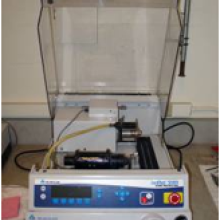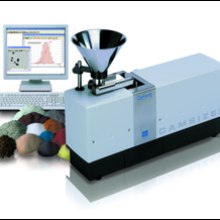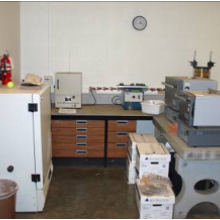A variety of equipment is available for geoarchaeological analyses, with recent upgrades from a 2007 STF grant. This includes equipment for conducting grain-size analysis; pH analysis; organic, carbonate, and phosphate analysis. Click for more information regarding the geoarchaeology program.
Retch Camsizer: The archaeology program has partial ownership with Earth and Space Sciences (ESS) to a Camsizer. This optically-based instrument is allows for students conducting geoarchaeology research to determine grain size to within ±1% over the range 30 µm to 30,000 µm(5φ to −5φ).
Thermolyne F6038CM Muffle Furnace: The Geoarchaeology lab houses two furnaces (Thermolyne 6000 and Thermolyne 4000) that are used to burning sediments and other materials at high temperatures to measure organic and carbonate loss.
Binder APT Drying Oven: This oven is commonly used to dry sedimentological and biological samples prior to further processing, to assist in low temperature geochemical reactions, to cure epoxy-impregnated biological specimens prior to sectioning, and to encourage drying of specialized laboratory glassware in a sterile environment. Similar to the muffle furnace, a digital programmable feature will alleviate the need to make multiple trips to the lab at night to change temperature settings.
Fluke 724 Temperature Calibrator 1400: This thermal calibrator is used to monitor thermal conditions in the oven and muffle furnace.
Bartington MS2 Meter and MS2B Dual Frequency Sensor: Together, these comprise the MS2 Magnetic Susceptibility System, used to measure the magnetic susceptibility in sediments and rocks.
Sieve Shaker (RO-TAP E CET-29-E): Combined with several sets of metric and imperial sieves, this equipment allows geoarchaeologists to calculate the relative percentage of different sized sediment grains (e.g., sand, silt, clay) to understand the depositional setting in which archaeological sites formed. This sieve shaker has a programmable timer and adjustable intensity.
Burrell Model DT Wrist-Action Flask Shaker: Similar to the sieve shaker, this automated equipment allows for shaking or mixing of flasks over long time periods.
Genie 2 Vortex G560 Vortex Mixer: This allows for the preparation of most geochemical and isotopic chemistry analyses in our lab involves thorough, rapid mixing of analytes.
Vacuum impregnation system: designed to encapsulate sample materials in an epoxy resin to facilitate preservation and sectioning of brittle or otherwise fragile materials.
Sartorius SE2 Ultra Microgram scale: In addition to the microgram scaled housed within the Microanalysis Lab.
Miscellaneous equipment:
- glassware
- hydrometers and pipettes for grain-size analysis
- desiccators for drying samples
- riffle splitter for dividing sediment samples
Example Research: The Department of Anthropology has made extensive use of the sediments lab under the direction of Drs. Julie Stein and Ben Marwick. Student research includes determining site formation processes at Pacific Northwest Coast sites, identification of animal husbandry in Hawai’i, testing the hypothesized location of Fort Clatsop.



